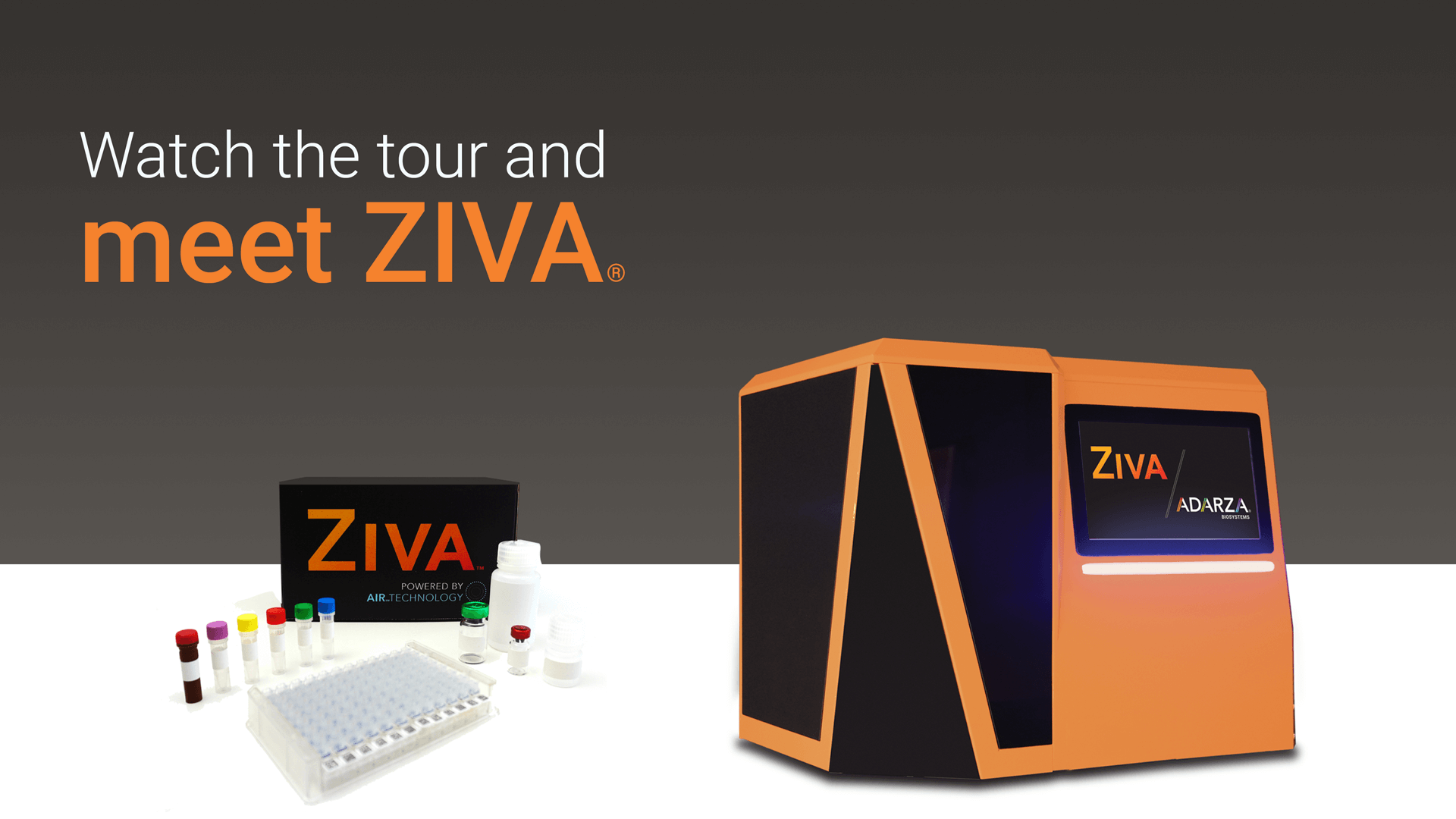ZIVA™ Platform
We're excited to help you experience ZIVA™
To get started now, just give us a call at
1-314-925-7800
Or complete the form below.
Get more info about ZIVA™







ZIVA’s uniquely designed consumable integrates individual biosensors in an 8-well strip which is further assembled into a 12-strip, 96-well ANSI format. The design enables automation of processing in the detection system.
ZIVA is a platform that can truly span the biomarker research continuum from large density arrays to lower plex, higher sensitive assays.
Traditional high density arrays manufactured on glass or membranes have limitations on automation due to the format and workflow. Such arrays typically require significant hands on time and cumbersome protocols. In addition, they suffer from quantitation, reproducibility and consistency due to the nature of the substrate of the array and increased opportunities for user-error due to significant amounts of hands-on-time. Luminex xMAP™ technology, a bead-based suspension immunoassay, offers protein arrays as large as 50-plex. However, limitations on plex size due to working assay ranges and dynamic range have been a challenge as well as sensitivity of detection with large arrays. Mesoscale Discovery® (MSD) is a planar array multiplex technology that offers increased sensitivity but is limited in plex capability (<10 plex per well). ZIVA, enabled by AIR™ technology, has a multitude of benefits that are key differentiators from other multiplex technologies: miniaturized biosensors with multiplex size as large as 100 targets; ability to expand assay working ranges and increase plex sizes by utilizing software optimized exposure time; a highly sensitive optical imaging format that is “tunable” and quantitative resulting from the ability to increase reflectance/signal by the addition of secondary reagents and “mass” enhancers; and a completely automated, user-friendly system offering a true walk-away experience. In addition, the rapid, turn-key style process for producing biosensors in high quality volumes deliver flexibility and plexibility. ZIVA is a platform that can truly span the biomarker research continuum from large density arrays to lower plex, higher sensitive assays.
The use of AIR™ technology for protein detection was first demonstrated in a study by the University of Rochester by designing an intimin-binding biosensor and measuring the change in reflectance as a function of intimin concentration1. Further demonstration of the multiplex capability of AIR™ was published showing the simultaneous detection of 14 cytokines in a serum matrix and achieving sensitivity of <10 pg/ml2. With the development of ZIVA, Adarza has transformed the AIR™ technology into a platform that can be used for biomarker discovery. ZIVA has been used to develop over 70 protein bioassays for human and mouse cytokine profiling with sensitivity as low as 1-10 pg/ml from a small (5 μl) sample volume. An example of a 22-plex human cytokine profile using ZIVA is shown in Figure 3.
There are three major areas in the vaccine market where multiplexing technologies have shown benefit: 1) mapping antigenic evolution of vaccine strains to help develop more effective vaccines, 2) using antigen arrays to monitor serological surveillance, and 3) assessing antigen-specific immunogenicity and immune response with combination and multivalent vaccines. AIR™ technology has been proven successful and advantageous in all three applications. The benefit of AIR™ technology for mapping antigenic evolution is the ability to screen hundreds of human antibodies targeted against variants of virus antigens, taking advantage of the label-free trait, to create an antigenic cluster map4. Current methods that monitor viral surveillance, such as influenza strains, are limited in the ability to measure more than one single-antibody response and throughput. Using AIR™ technology, hemagglutinin microarrays have been shown to provide a sensitive, high throughput, and label-free approach to monitor viral serology. Last, vaccine immunogenicity can be directly measured, using no expensive labels, especially taking advantage of the multiplexing capabilities when assessing multiple drug targets and multivalent vaccines in a single sample.
In addition to enabling profiling of protein biomarkers, AIR™ is an ideal technology to profile human autoantibodies with significant advantages over current detection methods. Traditional methods, whether slide based, planar array, or bead-suspension based, use autoantigens arrays to capture the autoantibodies in biological samples. However, traditional methods require the use of a secondary fluorophore-conjugated antibody against the different isotypes (IgG/IgM/IgA/IgE) for detection. The AIR™ technology eliminates the need for labeled secondary antibodies and streamlines both the process of assay development and workflow enabling direct detection of autoantibodies bound to their autoantigen. AIR™ technology has been shown to be very sensitive and quantitative in the detection of autoantibodies with superior results compared to Luminex or ELISA-based detection3. Because autoimmune response can trigger inflammation, inflammatory protein markers are also often measured, currently in separate assays. The AIR™ technology allows “mixed” targets to be arrayed on biosensors; thus, both autoantibodies and cytokine proteins can be measured simultaneously on the same biosensor using a single sample (work in progress).
Adarza®’s ZIVA™ platform, powered by AIR™ technology, is a very versatile system that has been proven to detect a variety of biological targets. The benefits of ZIVA™ over current multiplex methods are high plex capability, flexibility of biosensor array, ease of use, simple workflow, and high throughput. The entire package is a very cost-effective offering delivering quality and performance comparable to the industry standards. With ongoing initiatives to expand in new areas, including allergy and nucleic acid testing, ZIVA™ is well positioned to address key unmet needs in systems biology and drug discovery research as well as a future role in personalized medicine and diagnostics.


